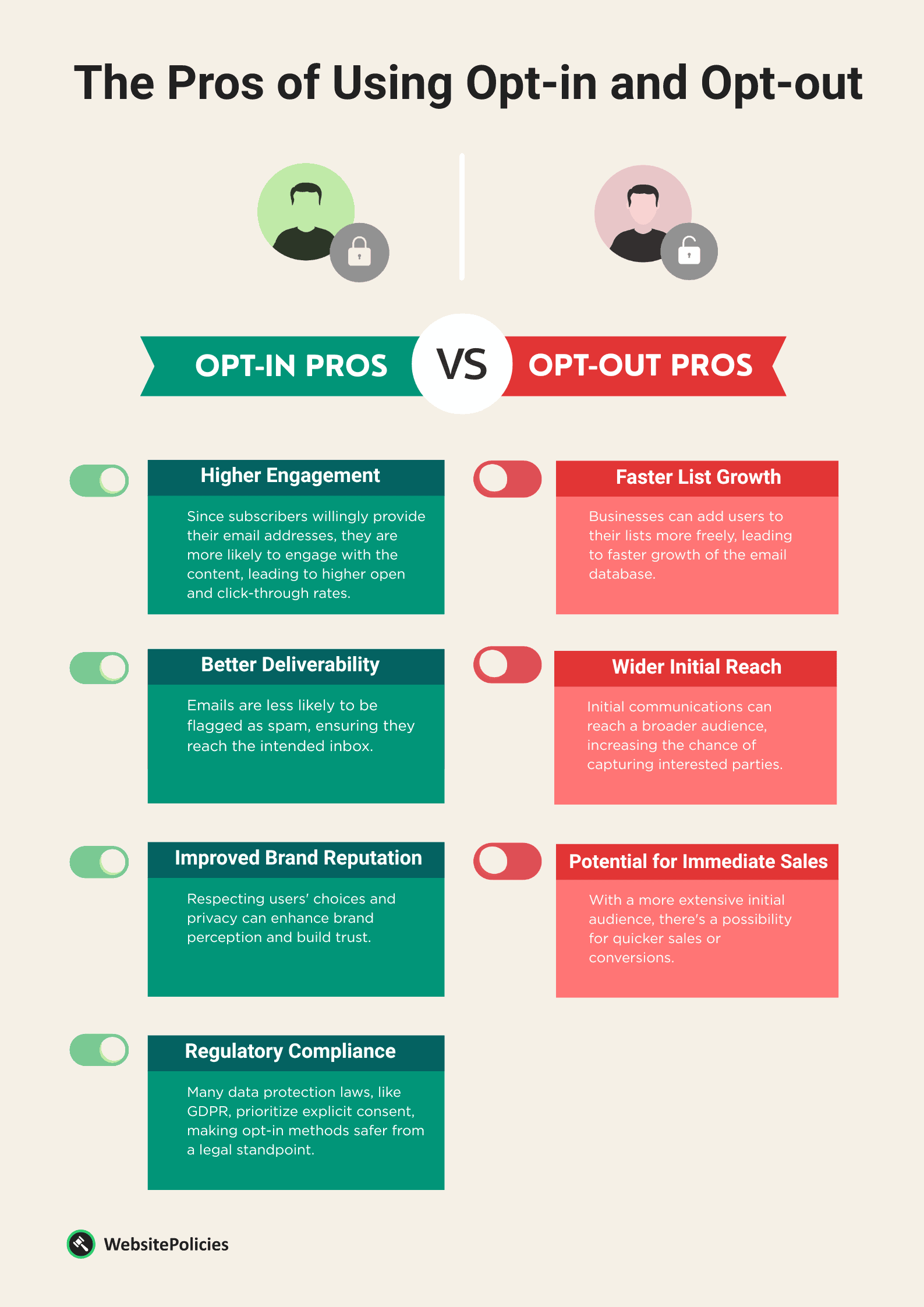In today’s digital age, every click, scroll, and tap carries weight. With mounting concerns over data privacy, how brands communicate with their audiences has come under scrutiny.
Enter the world of opt-in and opt-out approaches. While the former is a respectful nod to user consent, seeking explicit permission before diving into their inboxes, the latter plays on the presumption – assuming consent unless told otherwise.
In this article, we’ll look at both of them, their ethical implications, and their effectiveness in the digital marketing landscape, from understanding the nuances between single and double opt-ins to the potential pitfalls of the opt-out approach.
- The opt-in approach involves obtaining explicit permission for promotional content. It’s ethical, and legal, and builds trust with a receptive audience for more effective marketing.
- The opt-out can be suitable for existing business relationships, legacy lists, internal communications, B2B outreach, and subscription services, but it must prioritize user experience and rights.
- Opt-in requires user consent before sending, while opt-out presumes consent until users unsubscribe. Opt-in respects privacy and engagement, while opt-out risks negative perception and legal issues.
Table of Contents
PRO TIP: Take the hassle of writing your own privacy policy away with our privacy policy generator trusted by over 200,000 businesses. It’ll save you hours of work and possible costly legal mistakes.
What Is an Opt-In Approach?
The opt-in approach refers to the practice of obtaining explicit permission from individuals before sending them promotional content, typically through channels like email, SMS, or push notifications.
Opt-in practices are not only more ethical but also often more effective, as they ensure your messages are sent to an audience that has expressed interest in receiving them.
The opt-in model originates from a commitment to consumer privacy and a desire to create more meaningful and engaging interactions between brands and their audience. There are two primary forms of opt-in:
- Single Opt-In: A user provides their contact information, like an email address, to receive communications from a business. This action signifies their consent. However, there’s no secondary step to confirm their intention, so it can sometimes lead to invalid or low-quality leads.
- Double Opt-In: After a user signs up, they receive a confirmation message (often via email) with a link or action they must take to confirm their subscription. This two-step process ensures higher-quality leads, as users have shown a deliberate intention to receive communications.
A good practice is to clearly outline in your privacy policy why you collect someone’s personal information and how it’ll be used.
When to Use Opt-In?
There are quite a few reasons that make the opt-in approach a good strategy to keep in touch and communicate with their customers for any business. Let’s look at some of them.
Legal Requirements
In many jurisdictions, explicit consent is not just ethical, but a legal necessity before engaging users with promotional content.
For instance, the European Union’s GDPR mandates that businesses should seek affirmative consent from users prior to processing their personal data for marketing purposes. Non-compliance can result in severe penalties and damages to a company’s reputation.
Abiding by these regulations not only prevents legal consequences but also assures customers of the brand’s commitment to privacy and ethical data usage.
A well-written privacy policy is also something that’s legally required and goes hand-in-hand with the opt-in approach. Be sure to have it available and up to date.
Email Marketing
The efficiency of email marketing is contingent upon the authenticity of your subscriber list. Unsolicited emails or spam can harm your brand’s reputation, reduce deliverability rates, and even result in blacklisting by ISPs.
By using an opt-in approach, companies ensure they’re reaching out to genuinely interested individuals. This can lead to increased open rates, click-through rates, and overall engagement.
Thus, respecting the opt-in principle not only demonstrates ethical behavior but also optimizes email marketing performance.
SMS and Push Notifications
These direct messaging channels can easily be perceived as intrusive if not handled with care. Sending unsolicited SMS or push notifications can quickly irritate recipients, leading to negative brand perception and potential legal issues.
However, with explicit opt-in, the recipient has shown interest and given permission, making them more receptive to the content and reducing the chance of a negative response.
Ensuring explicit consent also provides a framework for more personalized and engaging content, leading to a more fruitful interaction.
It’s important to get explicit consent before sending promotional content or notifications via SMS or push notifications to avoid irritating recipients as they are more intrusive channels than email.
Building a Quality Subscriber List
Quality often trumps quantity in digital marketing. By focusing on an opt-in approach, companies ensure their subscriber list consists of individuals who have expressed genuine interest in their offerings.
This typically results in higher engagement levels, and better conversion rates, and creates customer loyalty. A well-curated, opt-in list ensures resources are utilized effectively, targeting those most likely to convert.
Avoiding High Unsubscribe Rates
Unsolicited messages often lead to higher unsubscribe rates, as recipients didn’t initially express interest. An opt-in approach mitigates this risk.
Users who willingly provide their contact information are more likely to be interested in the content, promotions, or updates they receive, leading to sustained engagement and minimizing opt-outs.
Reputation Management
Brand reputation in the digital age is fragile. Unsolicited communications can quickly lead to negative perceptions, with users labeling brands as “spammy” or inconsiderate.
By adopting an opt-in approach, brands show respect for user preferences, building trust and enhancing their reputation. In turn, this respect can foster positive word-of-mouth and brand loyalty.
Segmentation and Personalization
Opt-in strategies often involve collecting more than just an email address. By gathering information about user preferences, interests, or behaviors, businesses can segment their audience more effectively.
This segmentation allows for tailored messaging, ensuring users receive content that is most relevant to them, leading to improved engagement and conversion rates.
Cost Efficiency
Sending messages to a vast, disengaged audience can drain resources with minimal return on investment. Targeting an engaged, opt-in audience ensures that marketing efforts reach those most likely to respond positively.
This approach ensures more efficient use of resources, from reducing the cost per acquisition to improving the overall effectiveness of campaigns.
Building Trust
In an era of increasing digital privacy concerns, transparency is paramount. When brands ask for explicit permission before sending promotional content, they are signaling respect for user privacy.
This act alone can set a brand apart from competitors, building trust with potential customers, and assuring them that their personal data is in safe hands.
Adherence to Platform Policies
Many digital platforms, especially advertising and marketing tools, have strict policies against sending unsolicited content. Non-adherence can lead to penalties, including account suspension or banning.
By sticking to opt-in approaches, companies ensure they remain compliant, avoiding potential disruptions in their marketing efforts.
PRO TIP: By being upfront with your customers about what you will be doing with their contact details, you’ll have much better retention and engagement rates which will ultimately turn into sales.
What Is an Opt-Out Approach?
The opt-out approach in digital marketing represents a methodology where businesses send digital communications, such as emails or text messages, to users unless those users explicitly request not to receive them.
Essentially, it operates on the presumption of consent until informed otherwise.
In this model, recipients are typically given the option, usually via an “unsubscribe” link or similar mechanism, to remove themselves from further communications. Here’s a breakdown of the opt-out method:
- Initial Communication: A user might be automatically added to a mailing or subscription list when they make a purchase, sign up for a service, or engage in some other transaction. These communications might start without the user’s explicit request.
- Unsubscribe Option: Every communication sent under the opt-out model should offer a clear and straightforward way for recipients to stop future messages, whether that’s through an unsubscribe link, a settings preference, or a direct communication request.
Problem With the Opt-Out Approach
The opt-out approach in digital marketing, while expansive in reach, comes with distinct challenges. Brands seeking to adopt this method should be wary of potential pitfalls that could undermine their efforts.
Let me highlight a few ramifications an unsuspecting marketer may face with this method:
Potential for Negative Brand Perception
Unsolicited communications can easily annoy recipients. When consumers receive messages they didn’t explicitly ask for, it can feel intrusive and disrespectful. This annoyance can quickly translate into a negative perception of the brand.
Over time, even if the content might be relevant or beneficial, the mere association of the brand with unwanted messages can lead to an erosion of trust.
Moreover, word of mouth, especially in the digital age with social media, means negative experiences can be shared widely, amplifying the damage to the brand’s reputation.
Lower Engagement Rates
The effectiveness of any marketing strategy is measured, in part, by engagement. In the opt-out approach, since users did not actively express interest, the probability of them engaging with the content is significantly lower.
A message that isn’t catered to the recipient’s interests or desires tends to be ignored. Lower engagement means a lower return on investment for the communication effort.
Moreover, consistently low engagement rates can hurt future campaigns as platforms (like email service providers) might flag communications as spam or lower their priority in delivery.
Legal Implications
With a global emphasis on digital privacy and rights, regulations like GDPR in Europe, CCPA in California, and others worldwide have set stringent guidelines for digital communications.
These rules often require explicit and informed consent from users before sending promotional materials. Brands that rely heavily on the opt-out approach might find themselves inadvertently breaching these regulations.
Legal non-compliance can result not only in substantial fines but also in public relations crises. Being labeled as a brand that doesn’t respect user privacy can be a hard image to shake off and might deter potential consumers in the long run.
If you choose to use the opt-out approach in your marketing efforts, you need to do so with caution and a clear understanding of both legal boundaries and consumer preferences.
When is it Safe to Use Opt-Out?
There are some situations where it might be appropriate to get in touch with your customers or send them materials they didn’t explicitly agree to prior to that. Let’s look at them:
Existing Business Relationship
If customers have already initiated a business relationship, such as a purchase or a service subscription, they might expect to hear from the company.
For example, transactional emails, like order confirmations or account notifications, are typically acceptable under an opt-out regime.
Legacy Lists
If a business has an existing email list from a time before stricter data protection regulations, and these contacts have been regularly engaged with relevant content, continuing with an opt-out approach might be suitable.
However, reconfirmation or a shift to opt-in might be advisable in the long run, especially with international audiences.
Internal Communications
For larger corporations that have numerous departments or subsidiaries, opt-out methods can be employed for internal communications.
Employees or stakeholders might be auto-enrolled into newsletters or updates but given the option to unsubscribe.
B2B Context
In some business-to-business scenarios, especially where professional contacts are shared in networking or trade events, opt-out can be used for initial outreach.
However, these communications should always be relevant, and professional, and provide clear opt-out instructions.
Membership or Subscription Services
For organizations that offer memberships or subscriptions (like clubs or magazines), users might expect regular communications as part of their subscriptions. However, clear options to manage or opt out of certain notifications should always be present.
While there are scenarios where opt-out can be appropriate, it should be used wisely and always with the end recipient’s experience and rights in mind.
Opt-In vs Opt-Out Quick Comparison
Here’s a quick overview of the pros and cons of using both of these approaches to help you decide what’s best for you.
The Pros of Using Opt-in and Opt-out

The Cons of Using Opt-in and Opt-out

While opt-in offers a more targeted and engaged audience, ensuring legal compliance and a better brand reputation, it may grow at a slower pace.
On the other hand, opt-out can accelerate list growth and offer immediate sales opportunities, but it comes with higher risks, both in terms of legal consequences and potential harm to brand image.
The choice between the two approaches should be based on a brand’s specific goals, target audience, and risk tolerance.
Frequently Asked Questions
What is the opt-in approach in digital marketing?
The opt-in approach obtains explicit permission from individuals before sending marketing content, respecting privacy and ensuring engagement.
What is the opt-out approach in digital marketing?
The opt-out approach assumes targeting users by sending them marketing content that they may not have specifically agreed to receive.
What’s the difference between single opt-in and double opt-in?
Single opt-in involves user-provided consent; double opt-in confirms intent through a two-step process, ensuring higher-quality leads and consent.
How does opt-in benefit email marketing?
Opt-in ensures genuine interest, boosting open rates, click-through rates, and engagement, maintaining a strong reputation and optimizing email performance.
When is the opt-in approach legally required?
Many jurisdictions, like the EU’s GDPR, mandate explicit consent before sending promotional content to users, avoiding legal penalties and reputational damage.
What are the implications of the opt-out approach?
Opt-out risks annoyance, lower engagement, legal non-compliance, and tarnished reputation. Caution is needed, and it must align with user rights.



